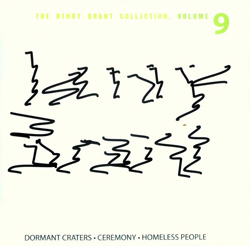Henry Brant
The Henry Brant Collection, Vol. 9
(Innova)

Whereas the previous volume in this set documented some of Brant's more humorous and arguably lightweight compositions, we return here to matters of sonic seriousness.
"Dormant Craters" (1995) is scored for 16 percussionists from a wide variety of backgrounds wielding an even wider assortment of instruments. Participants include drummers Pheeroan akLaff and Michael Veal, the ensemble Gamelan Son of Lion, the contemporary percussion group Pulse and the steel drum ensemble Tropical Soul. In addition to the array of objects to be excited that you might expect from those names, there is also an ocean of Asian gongs, pot covers, various bells and cymbals and a chromatic set of hand bells. Not surprisingly, the listener has all s/he could ask for in terms of aural delight; it pretty much comes with the territory and one can certainly just sit back and bask in the sounds. Those looking for some more structure, some backbone beneath the welter of noise, might not feel so rewarded. It's rather diffuse, sporting few rhythmic sequences of any length despite the instrumentation, and seems more of a display of coloration than a solid, dramatic work. As with much of Brant's work, it would certainly be more immersive when experienced live even though this piece is apparently not one of his "pan-spatial" compositions.
That pan-spatialism mixes with ritual on "Ceremony" (1954), for vocal quartet and chamber orchestra elements, including reeds, strings, percussion and brass. It's a lovely work with just a touch of dreaminess in the wordless vocals as they're buffeted by the strong trombones and plaintive strings. Its tinge of Romanticism causes one to think that it might have served, quite well, as a film soundtrack in its time.
"Homeless People" (1993, rev. 1997), when performed in concert, again has the musicians positioned throughout the hall. The pianist (here, Brant), working largely inside the body of the instrument with mallets, is onstage while the string players (the Onyx Quartet) occupy the corners of the room and the accordionist (Richard Yaus) positions himself equidistant from everyone else. The spatial arrangement doesn't appear to have been taken into account in this recording-everything is heard at equal volume and "distance" levels-which may be a shame but nonetheless, it's a fine, stirring work, the strings skittering and sighing nervously (recalling George Crumb, perhaps), the piano doleful but resolute and the accordion darting about emitting glints of mischief. Roles get exchanged during a section where the strings engage in playful pizzicato while the accordion mourns. This doesn't last however, the accordion playing a discordantly jaunty air while the quartet evokes ghostly hunger and sorrow; one can easily picture willfully nonobservant passersby gallivanting around the sidewalk-bound homeless. A fine, dense, troubling work.
Comments and Feedback:



More Recent Reviews, Articles, and Interviews @ The Squid's Ear...


|
|

